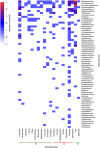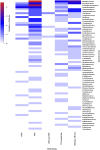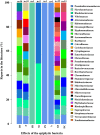A Functional Perspective Analysis of Macroalgae and Epiphytic Bacterial Community Interaction
- PMID: 29312241
- PMCID: PMC5743738
- DOI: 10.3389/fmicb.2017.02561
A Functional Perspective Analysis of Macroalgae and Epiphytic Bacterial Community Interaction
Abstract
Macroalgae are photosynthetic, multicellular, sessile eukaryotic organisms that offer diverse habitats for the colonization of epiphytic bacteria, therefore establishing biological interactions of diverse complexity. This review focusses on the interactions between macroalgae and their Epiphytic Bacterial Community (EBC); the main aims are to ascertain whether (1) the epiphytic bacterial groups differ at the phylum and genus levels of the macroalgae; (2) the methodologies used so far to study these microorganisms are related in any way to eventual variations of the EBCs on macroalgae; and (3) the EBC of macroalgae has a functional means rather a simple taxonomic grouping. Results showed firstly the taxonomic grouping of macroalgae does not explain the composition and structure of the EBCs. Secondly, the methodology used is important for describing EBCs; and thirdly, multiple bacteria can have the same function and thus to describe the functionality of EBCs it is important to recognize host-specific and generalist bacteria. We recommend the incorporation of a complementary approach between the taxonomic composition and the functional composition analyzes of EBCs, as well as the use of methodological tools that allow analysis of interactions between the EBCs and their hosts, based on the "holobiont" concept.
Keywords: biological interactions; epiphytic bacteria; holobiont; host-specific; macroalgae.
Figures







References
-
- Albakosh M. A., Naidoo R. K., Kirby B., Bauer R. (2016). Identification of epiphytic bacterial communities associated with the brown alga Splachnidium rugosum. J. Appl. Phycol. 28, 1891–1901. 10.1007/s10811-015-0725-z - DOI
-
- Almanza V., Buschmann A. H., Hernández-González M. C., Henríquez L. A. (2012). Can giant kelp (Macrocystis pyrifera) forests enhance invertebrate recruitment in southern Chile? Mar. Biol. Res. 8, 855–864. 10.1080/17451000.2012.692159 - DOI
-
- Armstrong E., Yan L., Boyd K. G., Wright P. C., Burgess J. G. (2001). The symbiotic role of marine microbes on living surfaces. Hydrobiologia 461, 37–40. 10.1023/A:1012756913566 - DOI
Publication types
LinkOut - more resources
Full Text Sources
Other Literature Sources

